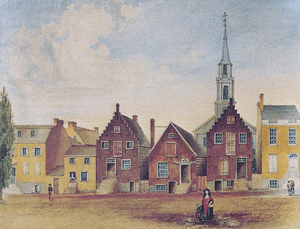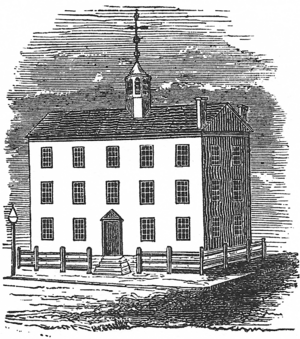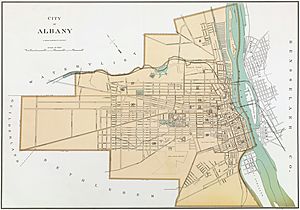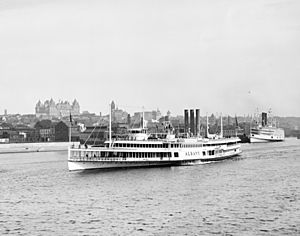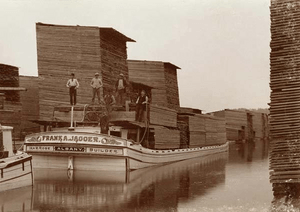History of Albany, New York facts for kids
The history of Albany, New York is a long and interesting story! It began even before Europeans arrived, when Native American tribes like the Mohican and Iroquois lived there. These tribes had strong ties with the land and later, with the first European traders.
In 1609, Henry Hudson claimed this area for the Dutch. The first European settlement was a fur trading post in 1614. Albany officially became a city in 1686. It took over from Poughkeepsie as New York's capital in 1797. Albany is one of the oldest settlements from the original thirteen colonies. It is also the longest continuously chartered city in the United States.
Modern Albany started as Dutch trading posts: Fort Nassau in 1614 and Fort Orange in 1624. The fur trade brought many people, who settled around Fort Orange. They formed a village called Beverwijck. In 1664, the English took control and renamed the town Albany. This was to honor the Duke of Albany, who later became King James II of England. The city officially received its charter in 1686. This Dongan Charter is the oldest city charter still in use in the nation.
During the late 1700s and throughout the 1800s, Albany was a major transportation hub. It sits at the northern end of the Hudson River, which ships can travel on. It was also the starting point of the Erie Canal. Some of the world's first railroad systems were here. Albany's main exports back then included beer, lumber, books, and ironworks. From 1810 to 1860, Albany was one of the ten largest cities in the United States.
In the 1900s, Albany opened one of the first commercial airports. This airport grew into today's Albany International Airport. The 1960s saw big changes to the city's skyline. The Empire State Plaza and the SUNY Albany campus were built. This was mainly thanks to Governor Nelson Rockefeller. Even though Albany's population decreased, many historic neighborhoods were saved. This was due to the efforts of Mayor Erastus Corning 2nd. He was the longest-serving mayor in U.S. history. More recently, Albany has seen growth in high-tech industries, especially in nanotechnology.
Albany has been a center for colleges and universities for over a hundred years. Much of its economy relies on state government jobs and health care. The city has been improving since the urban decline of the 1970s and 1980s. Its downtown and midtown areas are seeing new development. Albany is famous for its rich history, culture, architecture, and schools. It has won the All-America City Award twice, in 1991 and 2009.
Contents
Early History and Colonial Times (Before 1800)
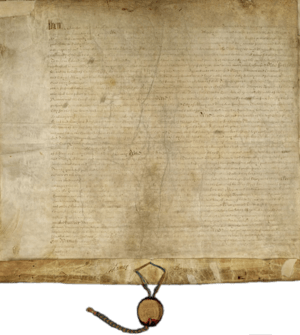
Albany is one of the oldest European settlements from the original Thirteen Colonies. It is also the longest continuously chartered city in the United States. The area was first home to Algonquian tribes. They had different names for the place. The Mohican called it Pempotowwuthut-Muhhcanneuw, meaning "the fireplace of the Mohican nation." The Iroquois called it Sche-negh-ta-da, or "through the pine woods."
The first European structure was a simple fort built by French traders in 1540 on Castle Island. But it was destroyed by floods soon after.
Dutch and English Settlements
Permanent European claims began in 1609. That's when Englishman Henry Hudson, exploring for the Dutch East India Company, arrived. He claimed the area for the United Netherlands. In 1614, Hendrick Christiaensen rebuilt the French fort. He named it Fort Nassau. This was the first Dutch fur trading post in what is now Albany. The fur trade caused some conflict with the French colony in Canada and among Native American tribes. Everyone wanted to control the trade.
In 1618, a flood ruined Fort Nassau. It was rebuilt in 1624 as Fort Orange. Both forts were named after the Dutch royal House of Orange-Nassau. Fort Orange and the area around it became the village of Beverwijck (meaning "Beaver District") in 1652.
Over the next few decades, the Mohawk, Mohican, and Dutch formed a good relationship. They worked together in the fur trade. This brought stability to the area. For example, Beverwijck was never attacked by the Mohican or Mohawk. Dutch traders often married or had families with Mohawk and Mahican women. Their children often identified with their mother's tribe.
In 1664, the English took control of New Netherland. They changed Beverwijck's name to Albany. This was to honor the Duke of Albany, who later became King James II. The title "Duke of Albany" was a Scottish title. It was usually given to the second son of the King of Scots. The name "Albany" comes from Alba, the Gaelic name for Scotland.
The Dutch briefly got Albany back in August 1673. They renamed it Willemstadt. But the English took permanent control with the Treaty of Westminster (1674). On November 1, 1683, the Province of New York was divided into counties. Albany County was the largest. It included all of present-day New York State north of Dutchess and Ulster Counties. It also included parts of Vermont. The city of Albany became the county seat. Albany officially became a city on July 22, 1686. This was thanks to Governor Thomas Dongan. The Dongan Charter was very similar to New York City's charter. At this time, Albany had about 500 people.
Albany's Role in Early America
In 1754, leaders from seven British North American colonies met in Albany's city hall, the Stadt Huys. This meeting was called the Albany Congress. Here, Benjamin Franklin presented the Albany Plan of Union. This was the first formal idea to unite the colonies. Even though it was never approved, it was an important step towards the United States Constitution.
The same year, the French and Indian War began. This war was part of a bigger conflict in Europe called the Seven Years' War. It was the fourth in a series of wars between colonial powers. The war ended in 1763 with the French losing to the British. This brought peace to Albany, which had been under constant threat.
In 1775, during the Revolutionary War, the Stadt Huys became home to the Albany Committee of Correspondence. This group took over Albany's government. In 1776, Albany native Philip Livingston signed the Declaration of Independence.
After the war, more people moved to Albany County. After Horatio Gates won against John Burgoyne at Saratoga in 1777, the upper Hudson Valley became peaceful. People from Vermont and Connecticut moved in. They saw the benefits of living on the Hudson River and trading in Albany. In 1790, Albany had a population of 3,498. This was a huge increase! In 1797, Albany officially became the permanent state capital of New York. Before this, the Legislature had moved the capital between Albany, Kingston, Poughkeepsie, and New York City. Albany is the second oldest state capital in the United States.
Growth and Innovation (1800 to 1942)
Albany has always been a center for transportation. In the late 1700s and early 1800s, new roads called turnpikes were built. By 1815, Albany was the main turnpike center in the state. These roads, along with canals and railroads, made Albany a key hub. Pioneers traveling to Buffalo and the Michigan Territory passed through Albany.
In 1807, Robert Fulton started the first successful steamboat line from New York City to Albany. By 1810, Albany had 10,763 people. It was the 10th largest city in the nation. In 1825, the Erie Canal was finished. It connected the Hudson River to the Great Lakes. This created a water route from the Midwest to New York City. It helped ship lumber and other goods, boosting trade. The original Erie Canal ended in Albany. Lock 1 was north of Colonie Street. The canal emptied into a man-made lagoon called the Albany Basin. This was Albany's main port until 1932.
In 1829, Joseph Henry, a professor at Albany Academy, built the first electric motor. He is considered "the foremost American scientist of the 19th century." Three years later, he discovered electromagnetic self-induction. The unit for this is now called the "henry." In the 1830 and 1840 censuses, Albany was the 9th largest city. It fell to 10th in 1850. This was the last time it was in the top ten.
Railroads and Industries
Albany also has a rich history with rail transport. Two major regional railroad companies were based here. The Delaware and Hudson Railway had its headquarters in Albany. In 1853, Erastus Corning, a famous businessman and former mayor, combined ten railroads. These railroads stretched from Albany to Buffalo. They formed the New York Central Railroad (NYCRR). The NYCRR was based in Albany until 1867. One of the ten companies that formed the NYCRR was the Mohawk and Hudson Railroad. This was the first railroad in New York State. It was also the first successful steam railroad with regular service in the country.
While transportation was key to Albany's success in the 1800s, industry also played a big part. Dutch and German immigrants started a successful beer industry. Much of the beer was exported. The city's location at the end of the Erie Canal gave it great access to raw materials and customers. Albany was also known for its publishing houses. For most of the 1800s, Albany was second only to Boston in the number of books produced. Iron foundries in the city attracted thousands of immigrants. Many historic buildings in Albany still have beautiful wrought-iron details. The iron industry declined by the 1890s.
Albany's other major exports in the 1700s and 1800s were furs, wheat, meat, and lumber. By 1865, there were almost 4,000 sawmills in the Albany area. The Albany Lumber District was the largest lumber market in the nation.
The city was also home to many banks. American Express was founded in Albany in 1850 as a mail delivery business. In 1908, Albany opened one of the first commercial airports in the world. It was the first municipal airport in the United States. It moved to its current location in Colonie in 1928. In 1960, the mayor sold the city's share of the airport to the county. It was renamed Albany International Airport after a big upgrade in the late 1990s.
Modern Albany (1942 to Present Day)
Erastus Corning 2nd was elected mayor in 1941. He was Albany's most famous mayor. He served from 1942 until his death in 1983. This made him the longest-serving mayor of any city in U.S. history. While he brought stability, some say he preferred to keep things the same. This meant less new development. Because of this, much of Albany's historic architecture survived. People have appreciated it more since the late 1900s.
During the 1950s and 1960s, Albany didn't see much growth. It lost over 20% of its population during Corning's time as mayor. Many downtown businesses moved to the suburbs. Governor Nelson Rockefeller (1959–1973) wanted to improve the capital city. He was the main force behind building the Empire State Plaza and the SUNY Albany campus. Mayor Corning was against the Plaza project at first. But he worked out a payment plan for it. This plan helped the county and city financially.
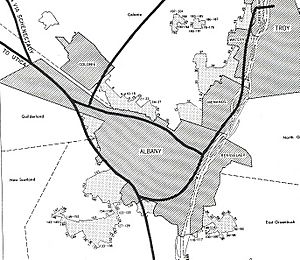
Another big project in the 1960s and 1970s was Interstate 787. This highway cut the city off from the Hudson River. This was a problem because the river was why the city was settled there in the first place.
After Mayor Corning died in 1983, Thomas Whalen became mayor. He worked to restore historic buildings. He also created the Mayor's Office of Special Events. This helped bring more festivals and art events to the city. Whalen is credited with bringing a lot of business investment to Albany.
In the 1990s, the State Legislature approved the "$234 million Albany Plan." This was a big building and renovation project downtown. Many state workers moved from the Harriman State Office Campus to downtown. This helped bring more people and life to the city center. More recently, there has been support for building a new Albany Convention Center downtown.
Images for kids
-
The Dongan Charter officially made Albany a city in 1686. It is the oldest city charter still used in the United States.
-
The Albany Congress met at Albany's Stadt Huys (City Hall) in 1754.
-
The steamer Albany leaving for New York City. In 1884, over 1.5 million passengers took this trip!
-
This 1955 map shows the planned expansion of the Interstate Highway System around Albany.


